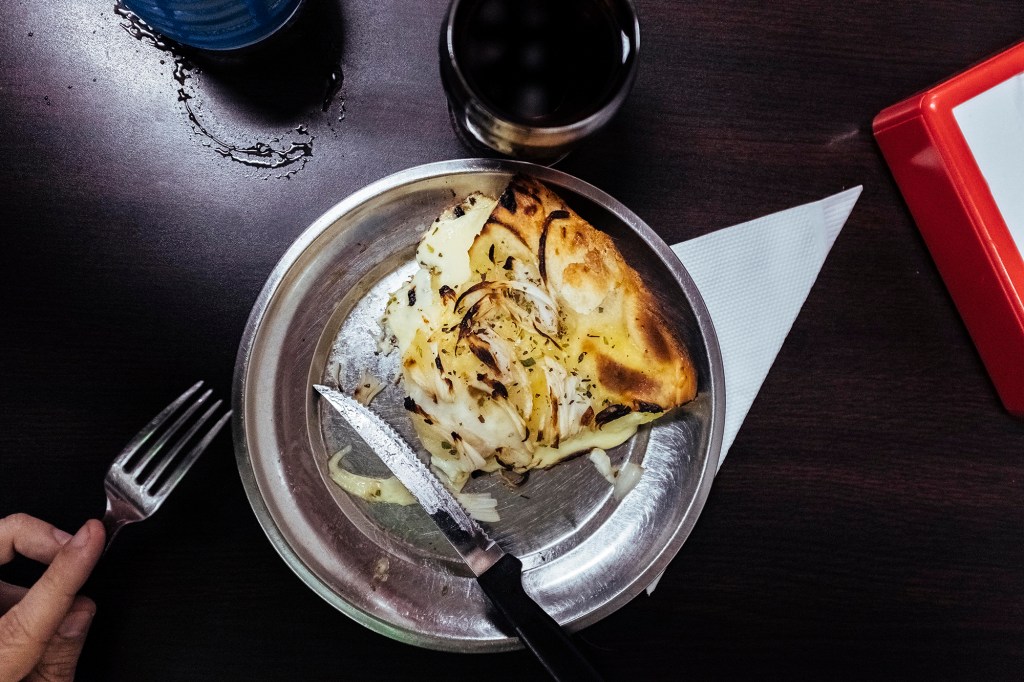“The world of pizza is really interesting,” starts Martin Auzmendi.
He studies the remains of his cortado as he carefully chooses how to begin. The thin layer of espresso has turned mud-brown and swishes thick like molasses at the bottom of his cup. His concentration breaks as metal dishes stacked with fugazzeta, a towering pizza made of two layers of dough stuffed with cheese and topped with charred onions and more cheese, zoom past and leave a greasy chemtrail in their path. They are placed in front of three elderly women who have swapped out the traditional evening coffee and sweet croissant for Buenos Aires’ idiosyncratic slice of pizza.
Videos by VICE
“But,” he continues, the words slowly stumbling out, “but I think that it is something that is very difficult for a foreigner to truly understand.”
It is a quarter past 7 PM and we are seated at a table in the back of Pin Pun, a 90-year pizzeria that lands in the middle of Buenos Aires’ ‘Pizza Avenue’—a 50-block stretch that is home to some of the city’s most celebrated shops. It is hard to keep my attention on Auzmendi with the scene inside. A mustached old cook spoons a mix of ground beef and olives into empanada shells like it’s second nature, while another tosses a half dozen others into a vat of bubbling pork lard. White backsplashes are punctuated by cans of tomatoes stacked into pyramids, and relics from nearly one hundred years of business, including a translucent red sign that proclaims, in Italian, that “This is where you’ll find the world’s best pizza.”

Pin Pun, like all great old pizza shops in the Argentine capital, feels like a living museum, but a rapidly gentrifying restaurant culture and the proliferation of modern looking pizza chains are transforming the face of an ubiquitous national icon. Right next door, a crisp and impersonal looking two-story pizza shop is set to open its doors on an imposing corner of the busy avenue. In the coming year, Sbarro will roll out 20 locations with its distinct brand of New York-style pizza.
The unique history of the porteño pizzeria is precisely what Auzmendi wants to record. He divides his time between organizing the Muza5k, an annual marathon that visits eight different pizzerias to uncover the city’s best slice of mozzarella, and obsessively visiting the city’s pizzerias to collect anecdotes and discuss the minutia of pizza culture for a book that will recount its story and the compulsive fanaticism pizza elicits here.
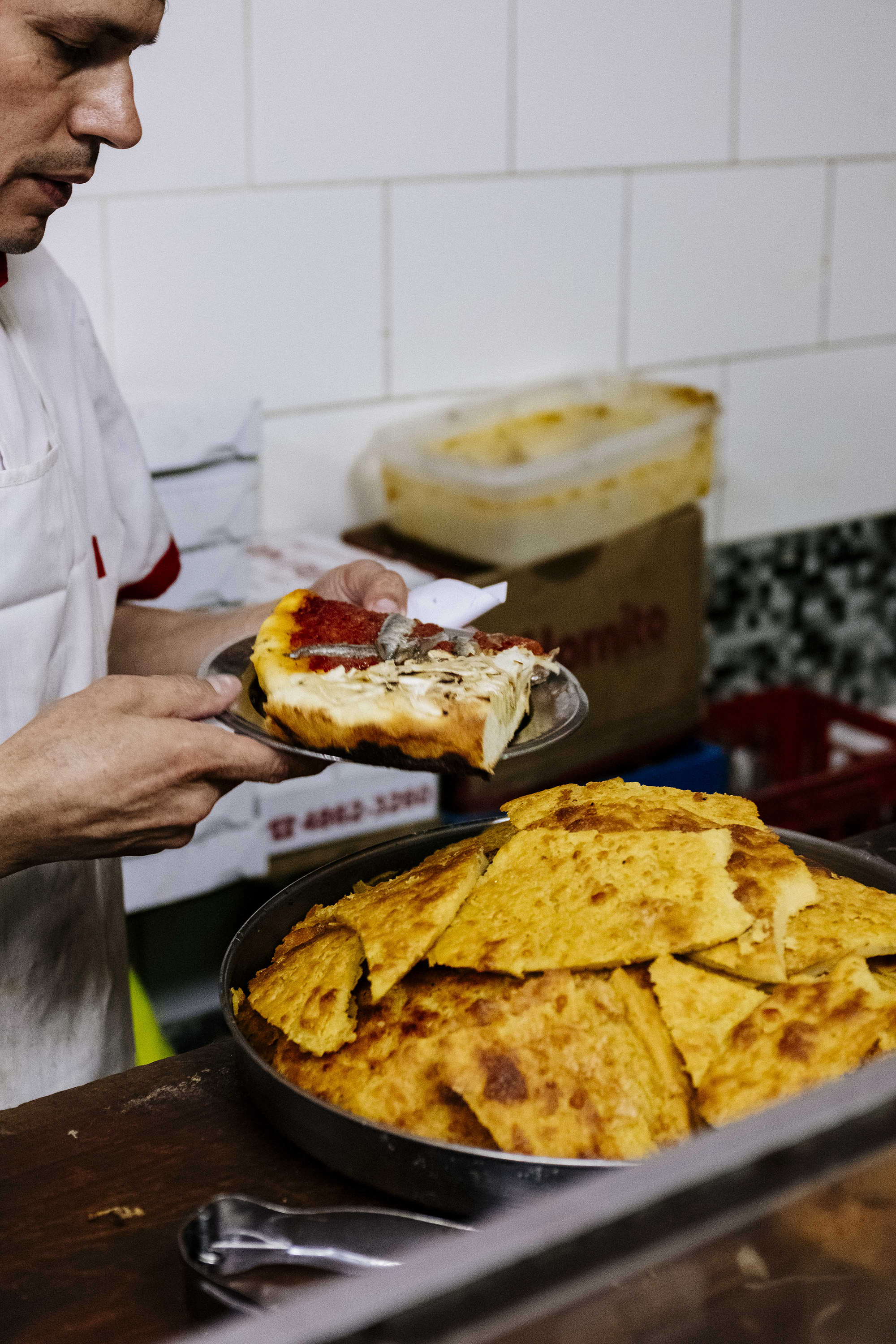
“I moved here from the northern suburbs in 2000 when I was 24. I wanted to understand Buenos Aires. The country was in the middle of an economic crisis. The city was completely different,” Auzmendi recounts. “I went to the movie theaters downtown a lot and afterwards I would always go to the pizza shops around there. Grabbing a slice was something that felt so ‘porteño.’ Getting out of the theater. Choosing your slice at the bar. Eating standing up. It is this whole ritual.”
To tell the story of pizza in Argentina is to tell the story of the Argentine. Pizza arrived to this corner of the world at the turn of the 19th century. Italians, mired in political and economic turmoil during their country’s unification process, escaped in waves. While Southern Italians tended to emigrate to New York, immigrants from the North headed towards South America. Italians quickly became the largest immigrant community, spreading throughout the country and becoming central to the development of local Rioplatense language and culture.
It was in the neighborhood of La Boca, amongst the squalor of the country’s predominantly Italian blue collar working class, that in 1882, the city’s first documented pizza was made in a bread oven rented by Neapolitan baker Nicolas Vaccarezza—a simple mix of dough, oil, and onion sold on the streets.
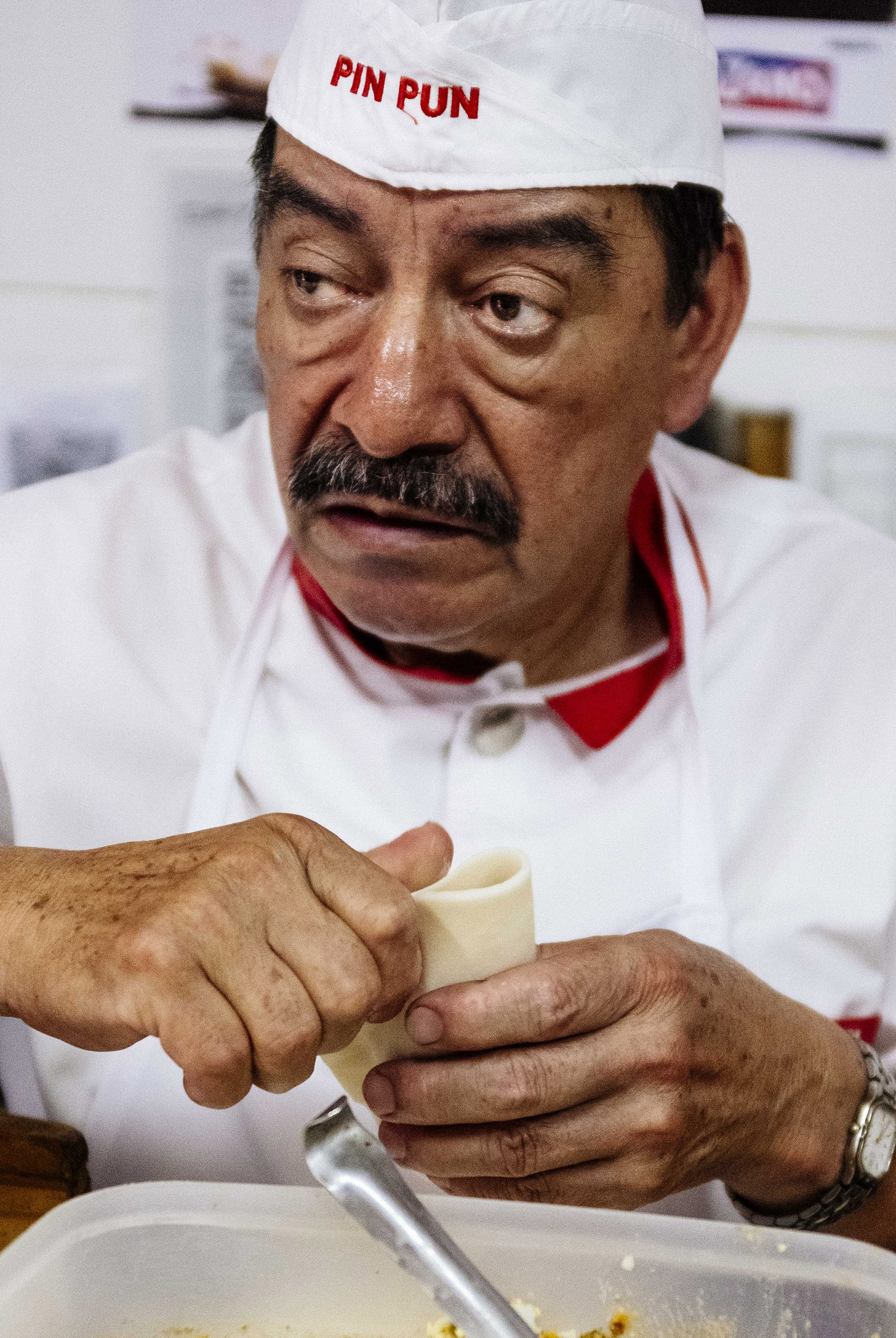
Ten years later, Genovese immigrant Agustin Banchero would begin selling pizza out of his own La Boca bakery. His business got its legs during an important time in the history of pizza. Riachuelo, which would later become a full fledged pizzeria, inaugurated just four years after the first pizza Margherita was made in Naples, and preceded the opening of the United States’ first pizzeria, Manhattan’s Lombardi’s, by nearly a dozen years. All three countries would go on to interpret modern pizza in wildly different ways.
In the case of Argentina, Banchero would introduce the fugazza con queso, a square pizza with two layers of dough stuffed with Lombardy-style quatirolo and topped with onions. The pizzerias that followed during a culinary boom in the 1930s were largely run by Spanish owners and cooks with little allegiance to Italian tradition. The thin-crust, subtly topped pies would be liberally transformed into thick, crispy doughs that overflowed with a handful of generously portioned ingredients.
The most important topping is, of course, cheese, which in Argentina, is a bastardized version of Italian mozzarella referred to as muza, a dry white block cheese. It is often the heaviest pizzas that win over Argentines’ allegiance—an indulgence which was the result of the abundance of food encountered by immigrants upon their exodus from war torn Europe. But in a country battling an estimated annual 25 percent inflation, soaring costs of ingredients mean many shops must opt for lower-quality ingredients in order to meet their clients insatiable appetites.
Despite that, 2,000 pizzerias dot the Argentine capital today, according to Javier Labaké, the Director of the School of Maestros Pizzeros, Empanaderos and Cocineros. The number, consistently on the rise, dwarfs all other types of dining establishments. According to a 2014 Spanish-sponsored study, porteños consume an estimated 14 million pizzas a year.
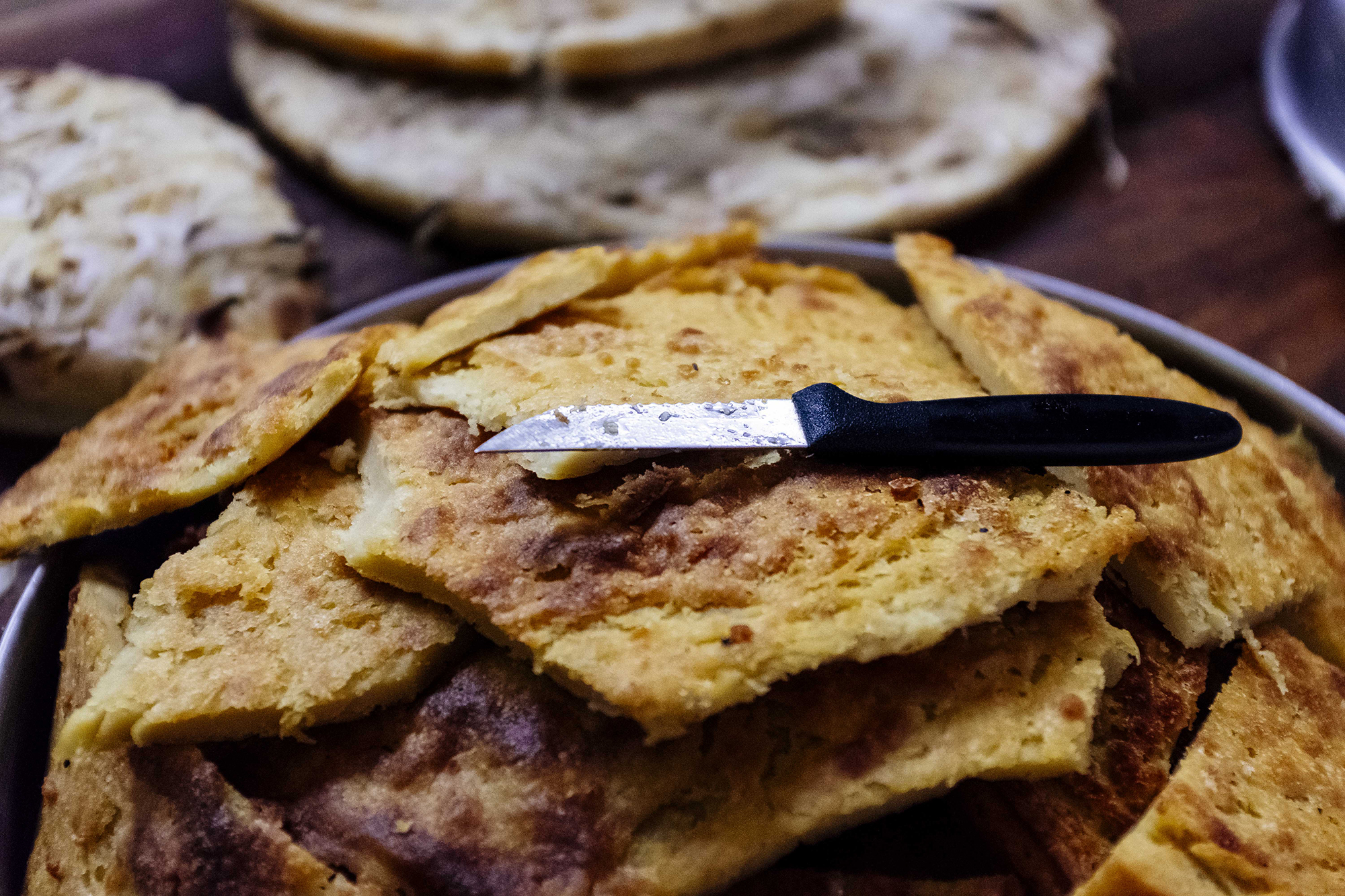
Their consumption isn’t just large—it borders on fanaticism. Argentines root and argue for their favorite pizzeria like they are defending their religion. After uploading an Instagram story at Pin Pun, three complete strangers wrote to me to insist that their spot was better. “That’s just us. We debate everything and we are passionate about tradition,” insists Auzmendi, “Food is important to us. When you get together with your friends or family, it doesn’t matter what you’re doing—you’re going to eat. Pizza, especially, is a part of a lot of get togethers.”
A small nebula of flour gathers in the air as Sergio Sosa silently brushes his palms clean and comes over to raise the shutter on the front door. “Ignacio is upstairs picking some strawberries,” he says matter of factly before whipping past my shoulder to scurry up a dark staircase.
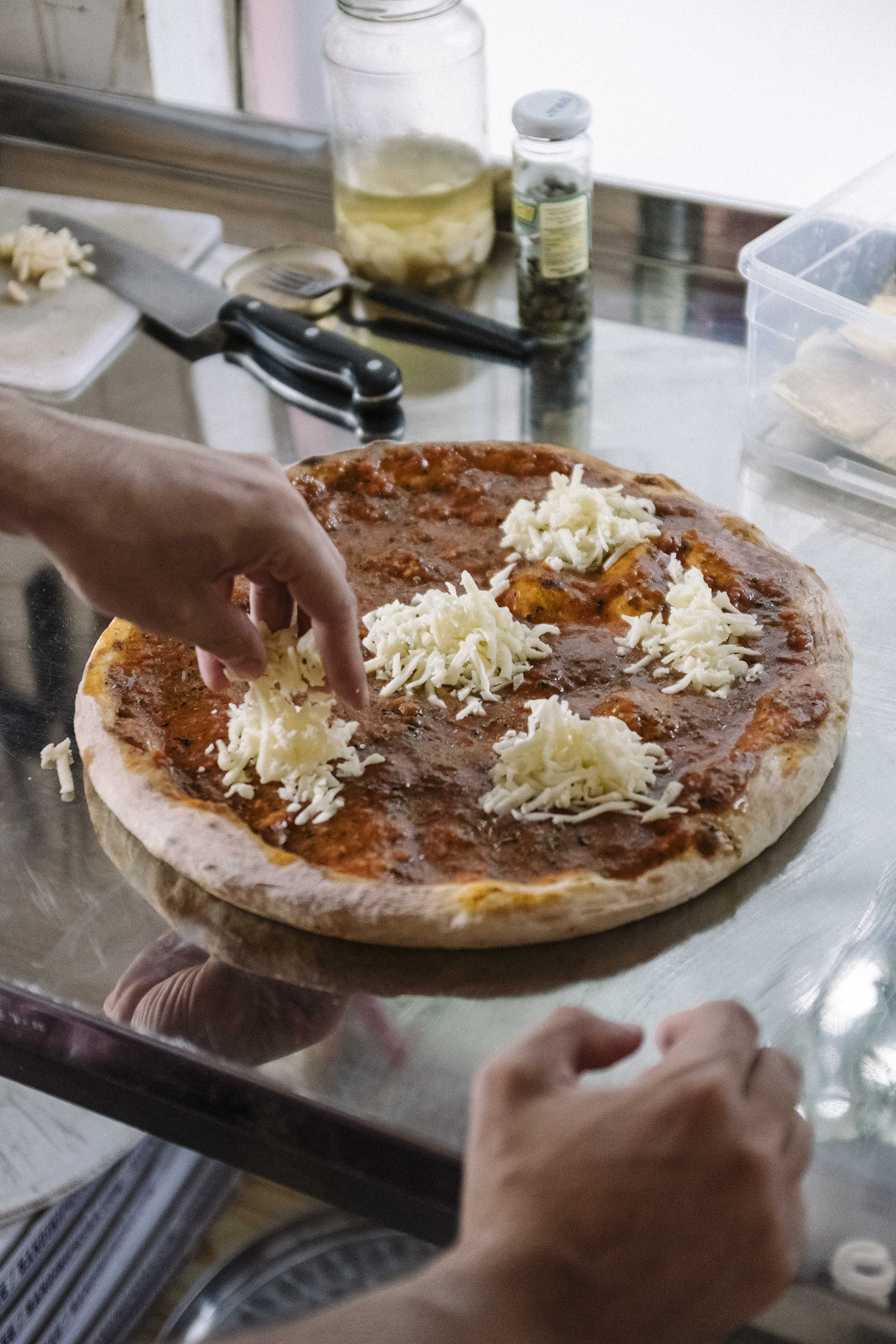
We are in the neighborhood of Villa Urquiza, an enclave that resembles a sleepy middle-class suburb more than a barrio in one of South America’s largest cities. But Bandini Pizzeria, a little corner shop painted in bright red and cobalt gold stands out like a sore, but welcome, thumb.
Ignacio Bandini’s energetic footsteps ring down, and he emerges in pajamas leftover from the morning that have transformed into the afternoon’s uniform. He wears an easy smile and a messy head of half curls. “I’m sorry, guys, we weren’t sure if you were coming today.”

Neither Bandini or Sosa are cooks by trade, but rather a carpenter and graphic designer, respectively. They form part of a small but growing wave of young restaurateurs who are moving away from a decade-long restaurant evolution that saw the growth of big chains as well as microbooms in Pan Asian, North American, and European food trends. Instead, they are attempting to save their grandparents’ traditions for a new generation of eaters. Despite this, Bandini is an anomaly, the only new project to offer an updated version of Buenos Aires pizza.
“I always liked the little shops in far-out neighborhoods. The places that have their little peculiarities. Everything is made by hand. The owner is there everyday. Maybe one day he makes your pizza with oregano and the next day he has some fresh parsley to throw on top,” starts Bandini. “Some of that has been lost. The romance of those spots.”
Sosa paints a generous ladle of sauce onto the pizza dough before tossing it into the wood-burning dome oven. His recipes pulls from both porteño deep dish al molde and an American approach to ingredients. The duo doesn’t only prefer their recipe for its flavor, but “if I were to use high-quality ingredients for a traditional pizza, no one would be able to pay for it.” The dough is fermented overnight and hand-stretched. Cheese is added sparsely, with robustly flavored sauce taking on the role as protagonist. Neighborhood traditionalists took a while to adjust to Bandini’s style, but now people are beginning to seek out the pizzeria from outside the city.
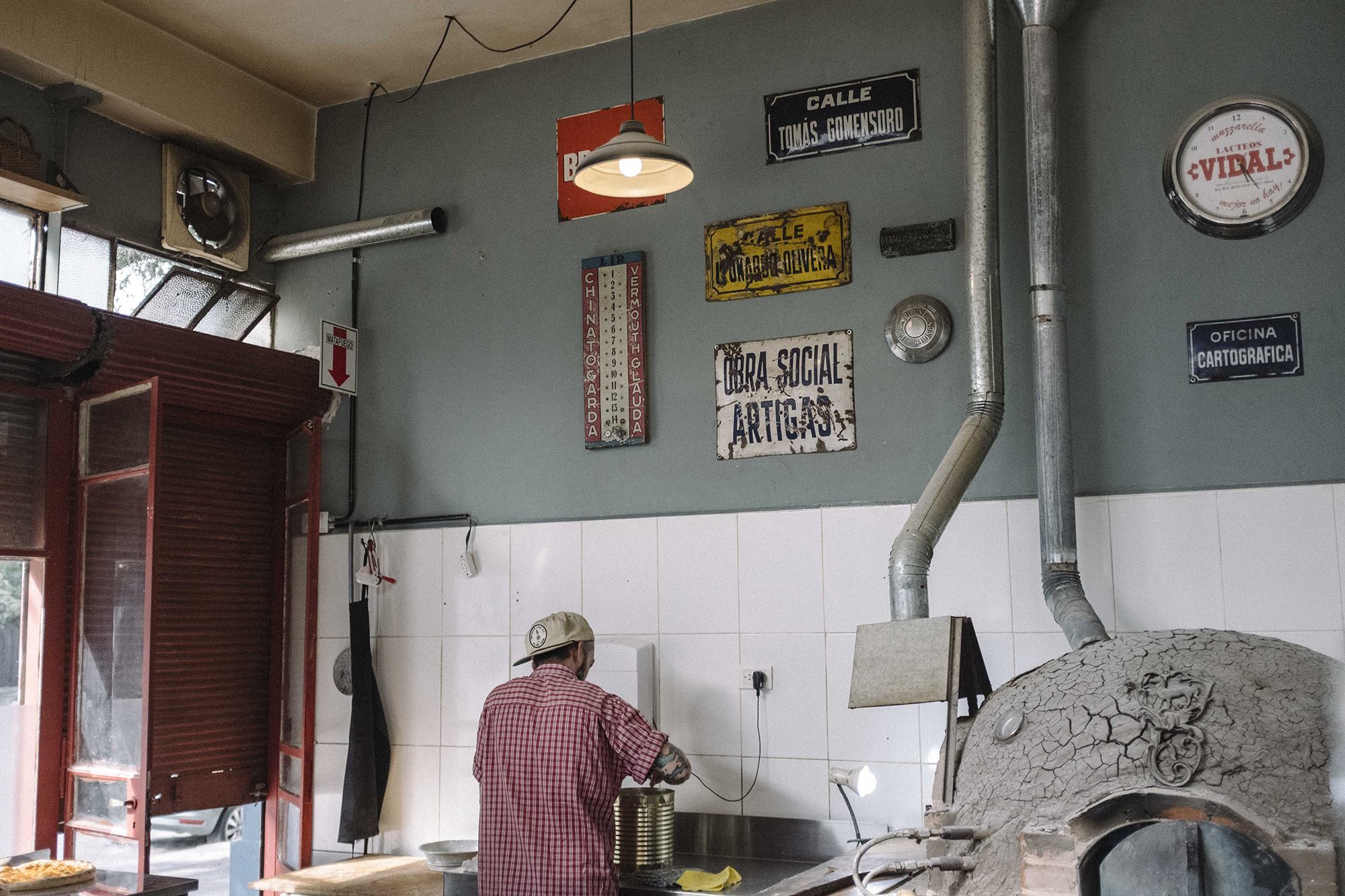
Sosa slides over the house speciality, the caprichosa, which comes topped with artichoke hearts, caramelized garlic, capers, Parmesan, and mozzarella. “I was coming home the other day and saw this chalk board outside a little convenience shop for a braised beef sandwich and oven-roasted potatoes. It was amazing. And it was just this little old lady cooking out of her own kitchen whatever she felt that day,” Ignacio recounts.
“And that’s really what this is about. Not trying to prove some point or say one pizza is better than the other. We just want to keep these kinds of places alive.”
